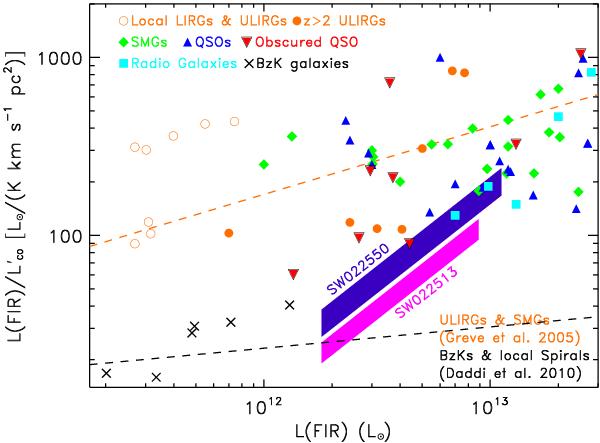Fig.5

Star-formation efficiencies (SFEs) given by the L(FIR)/ ratio as a function of the FIR luminosity for local LIRGs and ULIRGs (orange open circles; Solomon et al. 1997; Iono et al. 2009), z ≳ 2 ULIRGs (orange full circles; Bothwell et al. 2010; Yan et al. 2010), SMGs (full green diamonds; Greve et al. 2005; Solomon & Vanden Bout 2005; Tacconi et al. 2008), type I QSOs (full blue triangles; Solomon & Vanden Bout 2005; Coppin et al. 2008), obscured QSOs (upside-down full red triangles; see Table 2), radio galaxies (full cyan squares; Solomon & Vanden Bout 2005), and BzK galaxies (black crosses; Daddi et al. 2010). The dashed orange line is the best-fit relation obtained from a sample of ULIRGs and SMGs by Greve et al. (2005), and the black dashed line the relation obtained from local spirals and BzKs by Daddi et al. (2010). The two filled regions represent the SFEs estimated for SW022550 (purple) and SW022513 (magenta). Note that the FIR luminosities are affected by up to a factor of 2 uncertainties owing to the different methods applied to estimate them in the various samples, and to the uncertainties associated with the measured FIR/sub-mm/mm fluxes used in those estimates.
ratio as a function of the FIR luminosity for local LIRGs and ULIRGs (orange open circles; Solomon et al. 1997; Iono et al. 2009), z ≳ 2 ULIRGs (orange full circles; Bothwell et al. 2010; Yan et al. 2010), SMGs (full green diamonds; Greve et al. 2005; Solomon & Vanden Bout 2005; Tacconi et al. 2008), type I QSOs (full blue triangles; Solomon & Vanden Bout 2005; Coppin et al. 2008), obscured QSOs (upside-down full red triangles; see Table 2), radio galaxies (full cyan squares; Solomon & Vanden Bout 2005), and BzK galaxies (black crosses; Daddi et al. 2010). The dashed orange line is the best-fit relation obtained from a sample of ULIRGs and SMGs by Greve et al. (2005), and the black dashed line the relation obtained from local spirals and BzKs by Daddi et al. (2010). The two filled regions represent the SFEs estimated for SW022550 (purple) and SW022513 (magenta). Note that the FIR luminosities are affected by up to a factor of 2 uncertainties owing to the different methods applied to estimate them in the various samples, and to the uncertainties associated with the measured FIR/sub-mm/mm fluxes used in those estimates.
Current usage metrics show cumulative count of Article Views (full-text article views including HTML views, PDF and ePub downloads, according to the available data) and Abstracts Views on Vision4Press platform.
Data correspond to usage on the plateform after 2015. The current usage metrics is available 48-96 hours after online publication and is updated daily on week days.
Initial download of the metrics may take a while.


